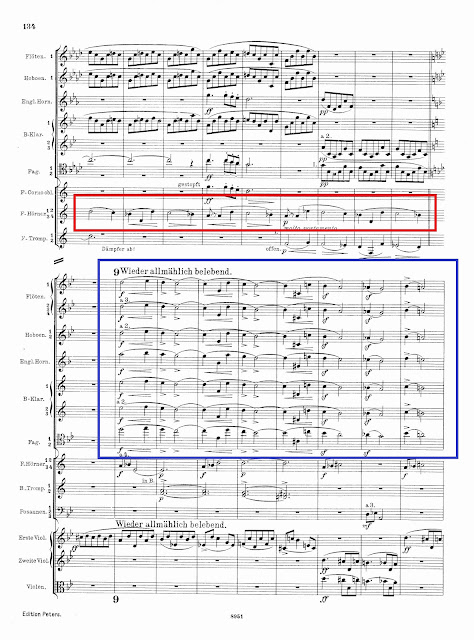DXLI. MAHLER, Gustav (1860-1911)
Symphony #5 (1901-02)
Part I
1. Trauermarsch. In gemessenem Schritt. Streng. Wie ein Kondukt
2. Stürmisch bewegt, mit größtre Vehemenz
Part II
3. Scherzo. Kräftig, nicht zu schnell
Part III
4. Adagietto. Sehr langsam
5. Rondo-Finale. Allegro -- Allegro giocoso. Frisch
Frankfurt Radio Symphony Orchestra
Andrés Orozco-Estrada, cond.
(1:16:38)
It was unusual for a new symphony not to have a key signature attached to its title. The first movement is in C-Sharp Minor and the last in D Major.
"From the order of the movements (where the usual first movement now comes second) it is difficult to speak of a key for the 'whole symphony,' and to avoid misunderstandings the key should be best be omitted." -- GM
Symphonies 1-4 (#1: Post XXI; #2: III; #4: LXXVII) all have vocal texts, while 5-7 (#6: CIV) are purely instrumental.
Mahler was happy. He had escaped a serious medical drama, and was director of the Vienna Court Opera and the principal conductor of the Vienna Philharmonic. His own compositions were beginning to meet with some success. In '01, he met Alma Schindler and the next year they were expected their first child, Maria.
[Maria would die of scarlet fever in five years, and a few years after that their marriage broke apart when Alma had an affair.]
Also, at this time, a set of the complete works of Bach were finally published in a massive number of volumes. (I got to see them for myself, when my teacher Nadia Boulanger showed me her copies. She had gone blind by studying them at night under candlelight.) Mahler's study of Bach led him to achieving greater and greater heights of magnificent counterpoint and divinely-inspired polyphony.
This is a huge orchestra:
4 flutes
3 oboes
3 clarinets
3 bassoons
6 horns
4 trumpets
3 trombones
tuba
percussion
harp
strings
First movement
Mahler opens this mammoth symphony with the blast of a solo trumpet, imitating the Generalmarsch of the Austro-Hungarian army!
The March concludes and the strings take up a funereal theme:

Mahler moves to B-Flat Minor as the tempo increases. The solo trumpet still takes the lead:
Moving from down a semitone to
A Minor. The music begins to swell, shedding some light from the darkness:
The movement concludes quietly with trumpet, flute, and bass drum -- and final
C-Sharp pluck from the lower strings:
Second movementAn angry intensity:
The storm passes. Flutes and winds toot out a simple accompaniment to a passionate melody in the cellos.
The initial theme returns -- chaotic -- until reduced to just cello and timpani:
Through many key changes, and stormy outbursts, this section near the end of the movement stands out for its calm serenity:
and this magical conclusion: a descending three-note motif --
C /
B in the celli/basses,
pizzicato, with the final note --
A -- in the timpani!
Third movementThis delightful
scherzo introduces several different waltz and ländler themes. Mahler requires French Horns players (all the brass, in fact) to be precise and durable. No composer before Mahler required such virtuosity ...
A new, lilting ländler theme:
Yet another theme, in the
horn, then
winds:
Pizzicato strings:
The movement ends with an urgent finality:
Fourth movementPerhaps the best known movement of any Mahler symphony -- scored for only harp and strings (imagine the brass so grateful for the rest!).
It has been stripped from its larger context in the symphony by
Visconti as the main theme of his 1971 film,
Death in Venice; by
Leonard Bernstein for the 1968 funeral of
Robert F. Kennedy; and was played in commemoration following the
9/11 attacks.
It is said to represent Mahler's love song to Alma, and he wrote a short poem to her to further illuminate the context:
Wie ich Dich liebe, Du meine Sonne
Ich kann mit Worten Dir's nicht sagen
Nur meine Sehnsucht kann ich Dir klagen
Une meine Liebe, meine Wonne
In which way I love you, my sunbeam
I cannot tell you with words
Only my longing, my love and my bliss
Can I with anguish declare
"With warmth" -- he moves the passion up a semitone from
F to
G-Flat:
With a magical intensity, Mahler brings this music to its conclusion --
suspended into its final breath ...
Fifth movement
The music seems suspended in midair ... motifs which will soon appear in their fullness, are in truncated form in the horn, bassoon, oboe, and horn again -- until the horns begin the rondo in a steady tempo:
Here we see the fruits of Mahler's study of Bach! A marvelous fugue with the traditional entrances staggered
tonic-
dominant-
tonic-
dominant:
and then it was over:
,_K.297_Page_1.jpeg)
,_K.297_Page_5.jpeg)
,_K.297_Page_7.jpeg)
,_K.297_Page_9.jpeg)
,_K.297_Page_20.jpeg)

,_K.297_Page_28.jpeg)

,_K.297_Page_34.jpeg)













































